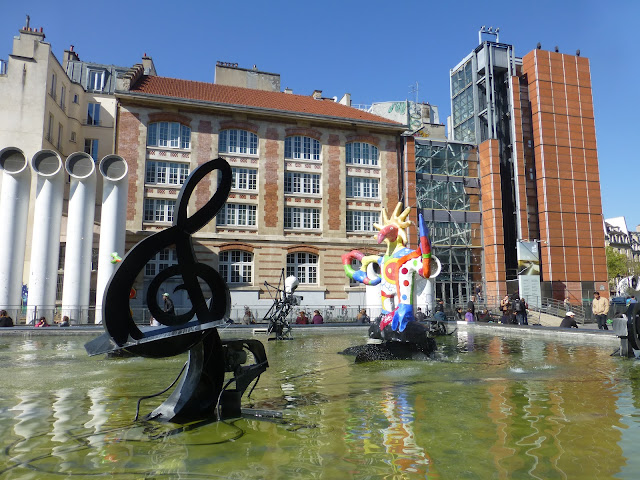Eglise Saint Merri
The Eglise Saint-Merri is located in the 4th arrondissement near the Centre Pompidou. It is dedicated to the 8th century abbot of Autun Abbey, Saint Medericus or Saint Merri, who came to Paris on pilgrimage and later died there in the year 700. Saint Merri's remains are still in the church's crypt. The church is home to the oldest church bell in Paris, cast in 1331. It also houses an 18th century organ by master craftsman Francois Henri Cliquot. It is well known among Parisians for its free weekly concerts.
Hotel de Ville
 Hotel de Ville is Paris's City Hall, which is located in the 4th arrondissement. It has been the headquarters of the municipality of Paris since 1357.
Hotel de Ville is Paris's City Hall, which is located in the 4th arrondissement. It has been the headquarters of the municipality of Paris since 1357.Since the French Revolution, the building has been the scene of a number of historical events, including the proclamation of the French Third Republic in 1870, and a speech by Charles de Gaulle on August 25, 1944 during the Liberation of Paris, when he greeted a crowed from a front window. Some of his words have remained famous:
Why do you wish us to hide the emotion which seizes us all, men and women, who are here, at home, in Paris that stood up to liberate itself and that succeeded in doing this with its own hands?
No! We will not hide this deep and sacred emotion. These are minutes which go beyond each of our poor lives. Paris! Paris outraged! Paris broken! Paris martyred! But Paris liberated! Liberated by itself, liberated by its people with the help of the French armies, with the support and the help of all France, of the France that fights, of the only France, of the real France, of the eternal France!
Since the enemy which held Paris has capitulated into our hands, France returns to Paris, to her home. She returns bloody, but quite resolute. She returns there enlightened by the immense lesson, but more certain than ever of her duties and of her rights.
I speak of her duties first, and I will sum them all up by saying that for now, it is a matter of the duties of war. The enemy is staggering, but he is not beaten yet. He remains on our soil.
It will not even be enough that we have, with the help of our dear and admirable Allies, chased him from our home for us to consider ourselves satisfied after what has happened. We want to enter his territory as is fitting, as victors.
This is why the French vanguard has entered Paris with guns blazing. This is why the great French army from Italy has landed in the south and is advancing rapidly up the Rhône valley. This is why our brave and dear Forces of the interior will arm themselves with modern weapons. It is for this revenge, this vengeance and justice, that we will keep fighting until the final day, until the day of total and complete victory.
This duty of war, all the men who are here and all those who hear us in France know that it demands national unity. We, who have lived the greatest hours of our History, we have nothing else to wish than to show ourselves, up to the end, worthy of France. Long live France!
 |
| Charles De Gaulle |
Notre Dame
Centre Pompidou
Rue des Barres
Rue des Barres in the 4th arrondissement is a relatively short pedestrianised street of 130 metres. 'Des barres' refers to a place where mills were located on the Seine. It is listed on one of the oldest plans of Paris and was created as early as 1250. It includes Eglise Saint Gervais, which was built on the foundations of the first known place of worship on the right bank. As an ancient street with a long history, Rue des Barres has a historic atmosphere and rustic attractiveness that is well worth a visit.
Notre Dame
The July Column, Place de la Bastille
Rue Francois Miron
Place des Vosges
Rue des Rosiers
Stravinsky Fountain
The Stravinsky Fountain is a shallow basin of 580 square metres located in Place Stravinsky, between the Centre Pompidou and the Church of Saint-Merri. Within the basin are 16 works of sculpture inspired by the compositions of Igor Stravinsky.
Jardin de l'Hotel de Sens
Bassin de l'Arsenal
Bassin de l'Arsenal is a boat basin which links the Canal Saint-Martin, and begins at the Place de la Bastille. It is part of the Parisian Canal Network and forms part of the boundary between the 4th and the 12th arrondissements. From the 16th century until the 19th century, an arsenal existed at this location. It is now a marina, for approximately 180 pleasure boats.











